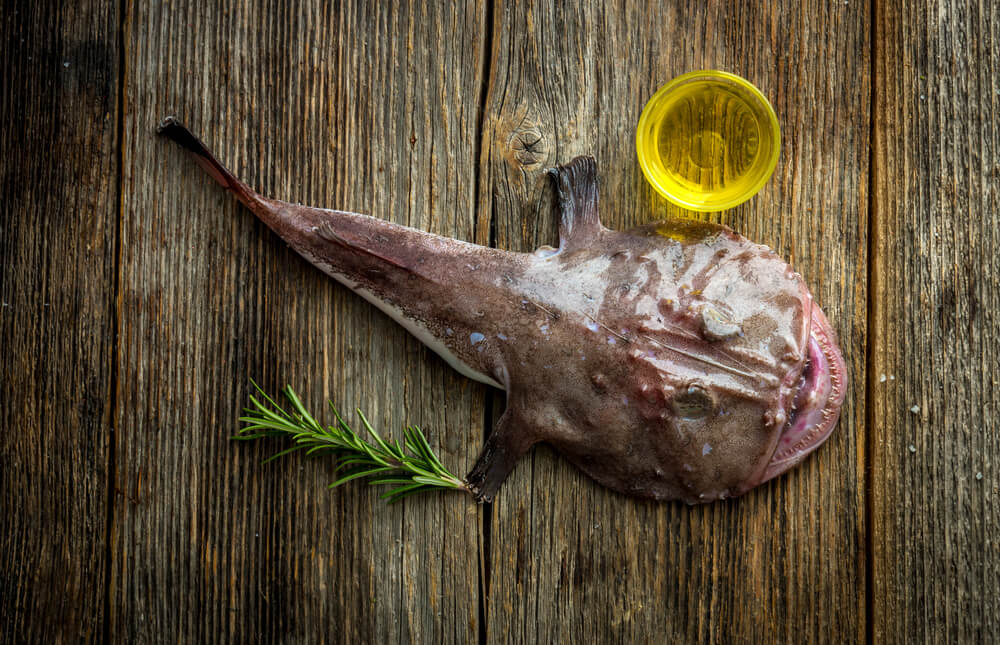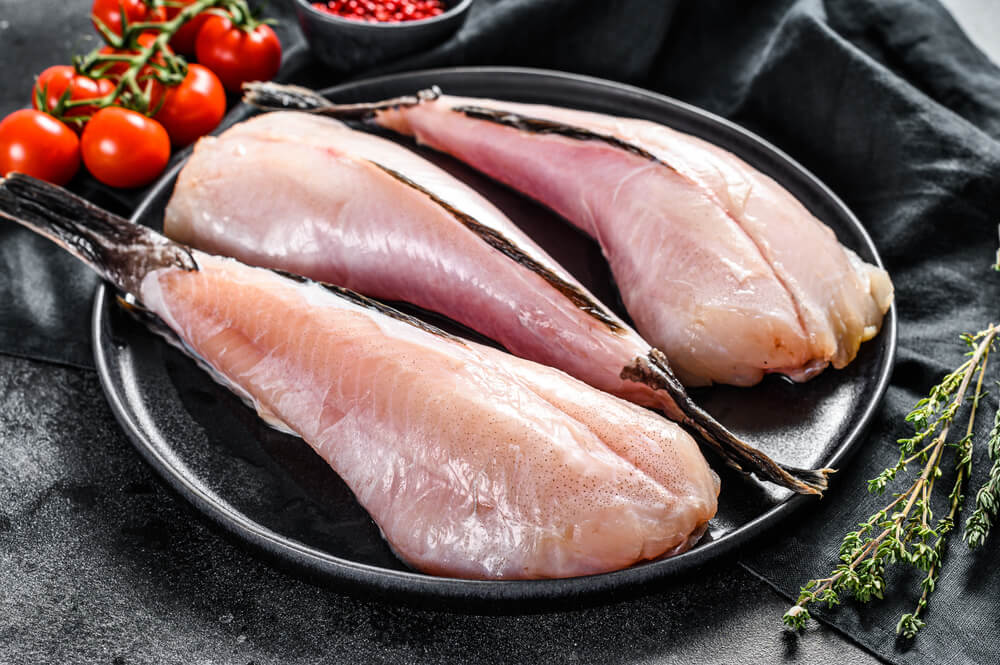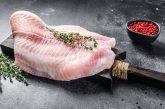
Monkfish, often referred to as anglerfish or sea monk, is a unique seafood that has captured the attention of culinary enthusiasts worldwide. Known for its distinct appearance and delectable taste, monkfish is a fascinating species worth exploring.
What exactly is monkfish? This remarkable fish belongs to the Lophiidae family and is typically found in the coastal waters of the North Atlantic Ocean. Its most notable feature is its large, flat head and wide mouth filled with sharp teeth, which contribute to its angler-like appearance. Despite its somewhat intimidating look, monkfish offers a surprisingly mild flavor profile that resembles that of lobster, a trait that has earned it the nickname “poor man’s lobster.”
The texture of monkfish meat is firm and dense, making it an ideal candidate for various cooking methods such as grilling, roasting, or pan-searing. Its versatility in preparation allows chefs to experiment with flavors and techniques while maintaining the fish’s natural sweetness.
As consumers become more adventurous in their seafood choices, monkfish continues to gain popularity not only for its taste but also for its nutritional benefits. Rich in protein and low in fat, this unique seafood provides essential nutrients without compromising on flavor.
Understanding what makes monkfish so special can enhance one’s appreciation for this exceptional ingredient. Whether you’re a seasoned chef or a home cook looking to expand your culinary repertoire, incorporating monkfish into your meals promises an exciting journey into the world of gourmet seafood delights.
The Habitat and Biology of Monk Fish
Monkfish, often referred to as the “poor man’s lobster” due to their similar taste and texture, are fascinating creatures that inhabit the deep-sea regions of the North Atlantic Ocean. These unique fish are well-adapted to their environment, thriving in depths ranging from 20 to over 1,000 meters. The monkfish habitat is primarily characterized by cold, dark waters where they can effectively employ their ambush predation tactics.
In terms of biology, monkfish are known for their distinctive appearance and biological adaptations. They possess a flattened head and an enormous mouth filled with sharp teeth, perfectly designed for capturing prey in the deep sea. Their ability to camouflage themselves on the ocean floor is another remarkable adaptation that aids in their survival.
Monkfish are benthic creatures, meaning they live at the bottom of the ocean. This lifestyle has influenced various aspects of monkfish biology, including their reproductive strategies and feeding habits. They feed on a variety of marine life such as fish and crustaceans by luring them close with a specialized appendage called an illicium.
Understanding where monk fish live and how they have adapted biologically provides insight into the complex ecosystems of our oceans and highlights the importance of sustainable fishing practices to preserve these intriguing deep-sea fish for future generations.
How to Cook Monk Fish and Popular Recipes

Monkfish, often referred to as the “poor man’s lobster” due to its firm texture and sweet flavor, is a versatile seafood option that can elevate any meal. Cooking monkfish requires a few simple techniques to bring out its best qualities. To prepare monkfish, start by removing the skin and membrane from the tail, a task made easier with a sharp fillet knife. Once cleaned, you can cut the fish into medallions or leave it whole for roasting.
When it comes to cooking tips for seafood like monkfish, remember that simplicity is key. Monkfish pairs well with bold flavors such as garlic, lemon, and herbs like thyme or rosemary. One popular method is pan-searing: heat olive oil in a skillet over medium-high heat and cook the fish until golden brown on each side, about 4-5 minutes per side should suffice depending on thickness.
For those looking to explore monk fish recipes further, consider trying your hand at roasting it with tomatoes and olives for a Mediterranean flair or wrapping it in prosciutto before baking for an added layer of flavor. Another delightful recipe involves poaching monkfish in a fragrant broth of white wine and saffron, a light yet luxurious dish perfect for impressing guests.
Whether you’re new to cooking monkfish or seeking fresh culinary inspiration, these techniques and recipes will help you make the most of this unique seafood delight.
Nutritional Benefits of Monk Fish
Monkfish, often referred to as the “poor man’s lobster” due to its similar taste and texture, is a seafood gem that offers numerous nutritional benefits. For those seeking a high-protein seafood option, monkfish stands out with its impressive protein content. A single serving of monkfish provides around 16 grams of protein, making it an excellent choice for those looking to increase their protein intake without consuming high levels of fat.
Beyond its protein-rich profile, monkfish is also low in calories and saturated fats, which aligns well with health-conscious diets. It contains essential nutrients such as vitamin B12 and selenium. Vitamin B12 plays a crucial role in maintaining nerve health and producing DNA, while selenium acts as a powerful antioxidant that helps protect cells from damage.
Incorporating monkfish into your diet can contribute to the myriad health benefits associated with eating fish. Regular consumption of fish has been linked to improved heart health due to the presence of omega-3 fatty acids, which help reduce inflammation and lower the risk of heart disease. Although monkfish is not particularly high in omega-3s compared to other fish like salmon or mackerel, it still contributes positively when included as part of a balanced diet.
For seafood lovers looking for nutritious options that support overall well-being while satisfying their taste buds, monkfish presents itself as a healthy choice worth exploring.
The Unique Taste and Texture that Sets Monk Fish Apart from Other Fishes
Monkfish, often referred to as the “poor man’s lobster,” is celebrated for its unique taste and texture that distinguish it from other fish. The taste of monkfish is subtly sweet and mild, akin to lobster or scallops, making it a versatile choice for a variety of culinary applications. This flavor profile allows it to pair well with an array of seasonings and sauces without being overpowering.
What truly sets monkfish apart is its firm, dense texture. Unlike the flaky consistency typical of many white fish varieties such as cod or haddock, monkfish boasts a meaty quality that holds up well in various cooking methods, from grilling to roasting. Its robust texture makes it an excellent candidate for dishes where the fish needs to maintain its shape and integrity.
When comparing the texture of monkfish with other fishes, one might find similarities with shellfish rather than traditional finned counterparts. This distinctive combination of taste and texture not only makes monkfish a unique offering in seafood cuisine but also explains why it’s often sought after by chefs looking to create dishes that are both flavorful and hearty.
Sustainability Concerns and Responsible Fishing Practices for Monk Fish
Monkfish, known for their firm texture and mild flavor, have become a popular choice in culinary circles. However, the rising demand for this species has raised significant sustainability concerns. The environmental impact of fishing monkfish can be profound if not managed responsibly. Overfishing poses a threat to their populations and disrupts marine ecosystems.
Sustainable fishing practices for monkfish are essential to mitigate these impacts. These practices include implementing strict catch limits to prevent overfishing and using gear that minimizes bycatch and habitat damage. For instance, certain trawling methods can harm the seafloor habitats where monkfish reside, so alternative techniques like hook-and-line or traps may be preferable.
Moreover, monitoring and regulation play crucial roles in ensuring that monkfish populations remain healthy. Fisheries management organizations often collaborate with scientists to assess stock levels and adjust quotas accordingly. By supporting fisheries that adhere to sustainable practices, consumers can help protect the delicate balance of marine life while enjoying this delectable fish responsibly.
In summary, adopting sustainable fishing practices is vital for preserving monkfish populations and maintaining ecological balance in our oceans. Through responsible consumption choices and adherence to regulated fishing methods, we can ensure that future generations continue to enjoy both the environmental benefits and culinary delights of monkfish.



